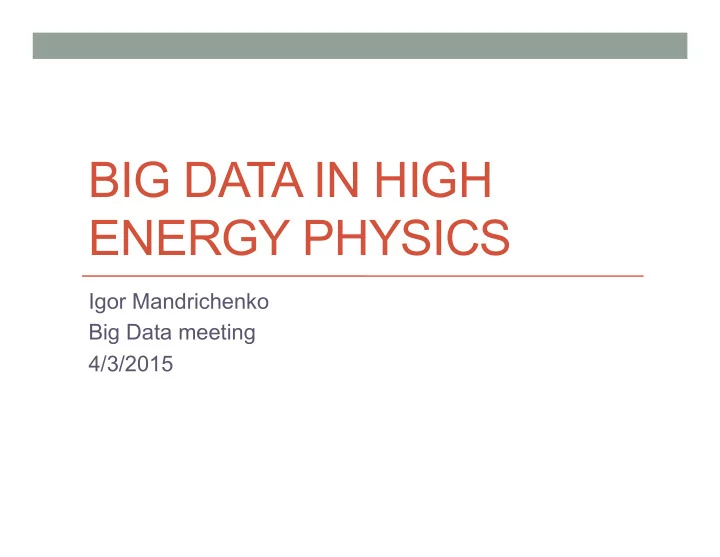

BIG DATA IN HIGH ENERGY PHYSICS Igor Mandrichenko Big Data meeting 4/3/2015
What is Big Data ? • For different industries and areas of science it means different things • Clicks, ad exposures, movies preferences, hyper text links, genome sequences, weather patterns, stock trades, etc. • Different data structures, different complexity, different requirements • Common: no moving data between fast (random access) and slow (sequential access) storage
Big Data as a paradigm shift • Big Data is the data processing methodology where all interesting data are immediately available for fast analysis at any time • Wikipedia: Big data is a set of techniques and technologies that require new forms of integration to uncover large hidden values from large datasets that are diverse, complex, and of a massive scale.
Benefits of Big Data • Fast data analysis • No competition over resources • No data retrieval latency • High parallelism • Broader set of problems available for solution
What does it mean for HEP ? • To have all raw and processed data permanently stored in a scalable random access storage with fast, efficient data lookup (indexing) capabilities • Benefits: • more efficient use of computational resources (CPU) – no need to wait for data staging • Fast, agile data (re-)processing, analysis • Additional areas of research
Traditional HEP approach • Collect or produce data (DAQ, MC) • Write raw data to tape as fast as you can, via disk buffer • Process or reduce data (reconstruct events) • Read data from tape to disk • Write reduced data to disk and then back to tape • Analyze data • Read reduced data (and often raw data) from tape to disk • Skimming: Filter “interesting” data – read each event, decide whether it is interesting • Save “interesting” data for future analysis (write to disk and then to tape) • Every group or individual saves their own “interesting” sets, duplicating data • Further reduce data into physical results (histogram, mass, cross- section, etc.)
Traditional HEP approach
Traditional HEP approach • Tape is primary storage of all data from raw to intermediate results of the analysis, “write once, read multiple times” • Disk is a buffer through which tape storage is scanned. Not considered reliable • Data need to travel between tape and disk many times • It is important to be able to filter and save “interesting” data once and reuse it many times so that there is no need to re-scan whole dataset again and again
Big Data technologies • Storage • Scalable, redundant, efficient -> distributed • Elastic • Databases ? • SQL vs. noSQL • Map/reduce • Exists since MPI, at least • Successfully used by Google for data management and analysis
SQL or no SQL ? • Relational model: • Powerful data representation, management and analysis tool • Move some simple calculations to the server side • selection, sorting, aggregation • Confined to single server architecture -> limited scalability • ~10-100TB limit • Non-relational model: • Key-value storage plus some extras from RDB concept • Secondary indices • ACID • Instead of choosing one or the other, we can use both • Store data in a key-value storage • Store metadata, structural information in a RDB
Proposed Big Data Approach • Collect data, store on disk • Index data (batch map/reduce task) • Data processing (event reconstruction) • Read new raw data from disk – use index to define what is new • Reconstruct • Write reconstructed data to disk (associate with raw data) • Index data • Analysis • Use index to find potentially interesting events • Create and populate your own index • Analyze interesting data • Update your index • Produce physical results
Proposed Big Data Approach
Big Data vs. Traditional • Disk is primary storage of data, instead of tape • 3-5 times replication • Tape – last resort backup, “write once, read hopefully never” • Data Representation – BLOB, application specific format • Whole data set is always immediately available from disk • Direct, random access as opposed to sequential in case of tape • Indexing instead of filtering and copying • Each piece of data exists in one (x number of replicas) instance, usable by anyone • Group or an individual user can create arbitrary indexes
Sizing • Event Storage - ~1-5 PB • ~1000 nodes by ~3TB • Up to ~2PB effective size (2-3 times replication) • Index Database • ~10 TB easily • Maybe up to ~100 TB
Big Data Approach - pieces • Event Storage • Key (event id) -> BLOB (event data) database or storage, no SQL database • Disk based, distributed, replicated, elastic, scalable • Some computational capabilities • Backup to tape • Index Database • User defined criteria -> event ID • Small because it does not contain event data • Can be a relational database – multidimensional indexes, complex queries executed by the database • Indexing process • Map/reduce approach seems to fit well • Periodically running jobs, which analyze event data and populate indexes • Trick: make sure to process only one replica of each data item
What is Big Data • Big Data is not about size • It has been known for decades how to collect and record petabytes of data • Big Data is about the ability to quickly analyze large amounts of data • Data can be collected and stored quickly, and then always “immediately” available for the processing (reduction) and analysis
Recommend
More recommend